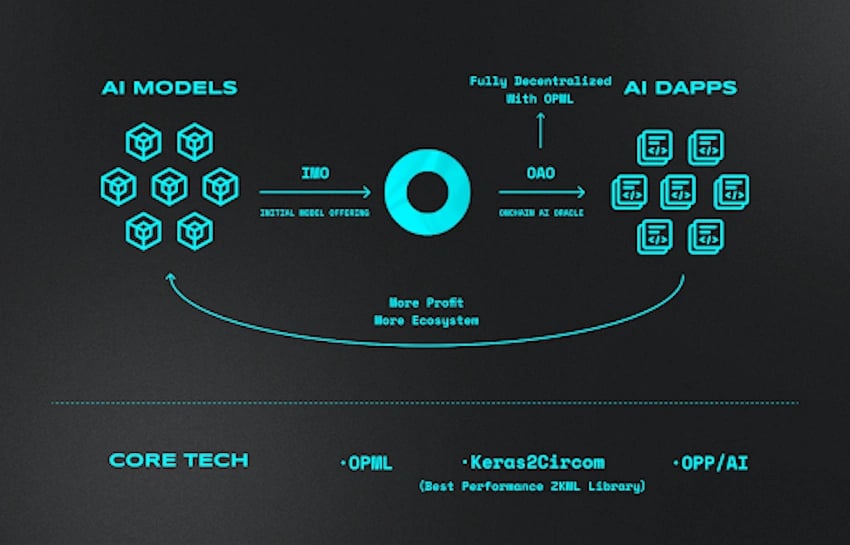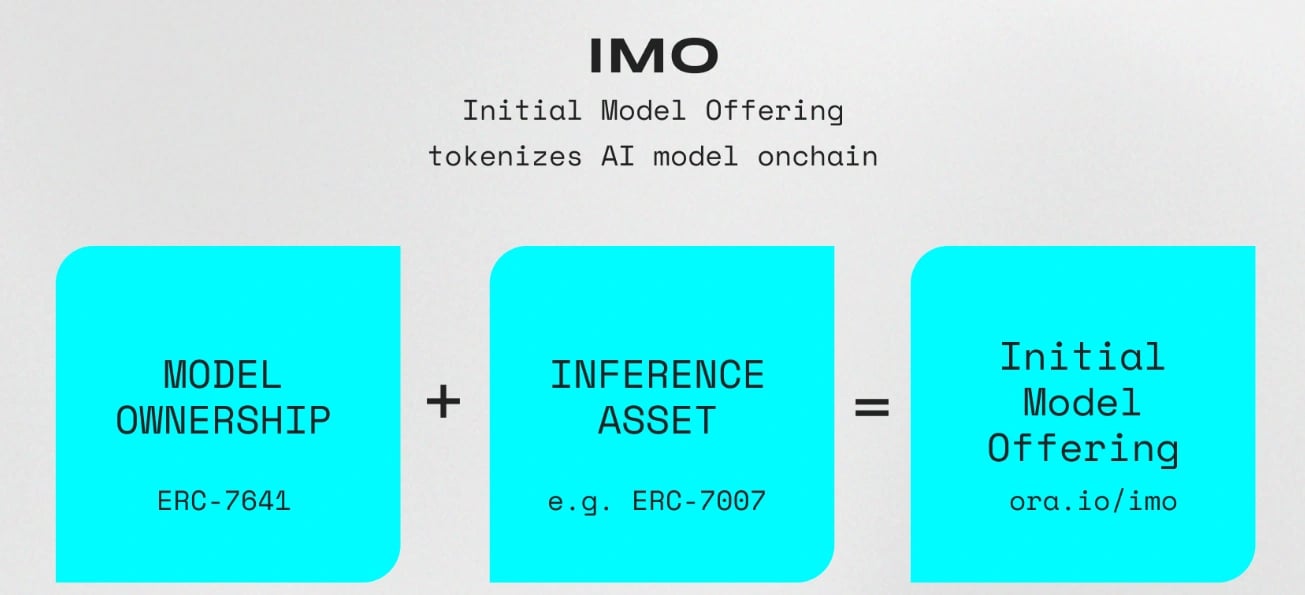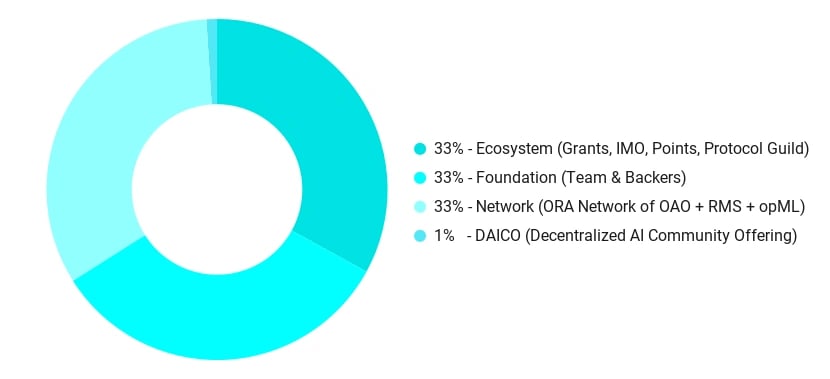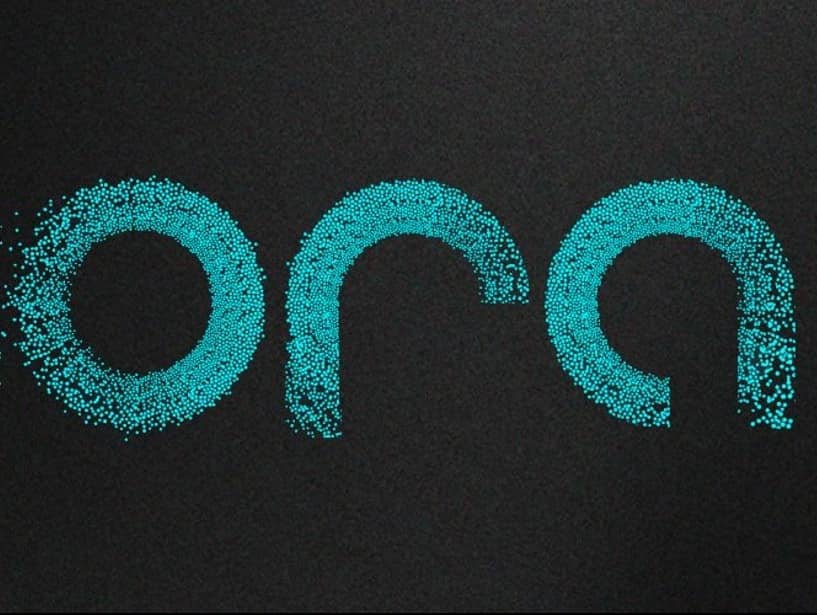Subscribe to wiki
Share wiki
Bookmark
ORA Protocol
The Agent Tokenization Platform (ATP):Build autonomous agents with the Agent Development Kit (ADK)
ORA Protocol
The Ora Protocol is a verifiable oracle protocol that brings AI and complex computation on-chain. It was co-founded by Kartin Wong in September 2022. [1][2]
Overview
Ora Protocol provides blockchain-agnostic infrastructure for integrating artificial intelligence with decentralized applications. It offers tools for developers to run and verify AI computations directly on-chain, aiming to create systems that are both trustless and decentralized. The protocol focuses on enabling scalable, verifiable AI within blockchain environments. Its primary service, the AI Oracle, allows smart contracts to access AI functionalities through a decentralized network of nodes using the TORA client. This system is supported by optimistic machine learning (opML) for ensuring computational integrity. Ora also introduces Initial Model Offerings (IMOs), a method for tokenizing AI models using ERC-7641. This approach supports funding for open-source AI development and distributes revenue to tokenholders tied to using these models in decentralized applications. [3]
Products
Onchain AI Oracle (OAO)
Ora Protocol’s on-chain AI Oracle is a verifiable oracle system designed to bring machine learning inferences onto the blockchain. It enables smart contracts and decentralized applications to access and verify outputs from advanced AI models like LLaMA 3 and Stable Diffusion.
The system is powered by optimistic machine learning (opML), which uses fraud proofs to validate computations and ensure trustless execution. Compared to zero-knowledge machine learning (zkML), this approach offers reduced computational cost and improved scalability.
The AI Oracle consists of smart contracts and off-chain components. The opML contract manages fraud proofs and verifiability, while the AIOracle contract facilitates the interaction between off-chain ML nodes and on-chain callers. User contracts send AI requests and receive results. ORA Nodes, running the TORA client, are responsible for submitting and validating inference results across the network. [4]

Optimistic Machine Learning (opML)
opML (Optimistic Machine Learning) is a framework that enables scalable and efficient machine learning inference on blockchain networks. It allows advanced AI models to operate in decentralized environments without overloading the blockchain or relying on centralized systems. Inspired by optimistic rollups, opML assumes ML computations are valid unless challenged, significantly reducing the need for immediate on-chain verification and making complex AI applications more practical on-chain.
The system achieves its efficiency through off-chain execution of ML tasks, with only disputed results undergoing on-chain validation. This is done via a fraud-proof mechanism: results are submitted by a service provider, and validators have a set period to challenge them. If a dispute occurs, the system identifies the exact computation step and verifies only that step using the Fraud Proof Virtual Machine (FPVM). This method preserves computational resources while ensuring accuracy and integrity.
Compared to Zero-Knowledge Machine Learning (zkML), opML avoids the high costs of generating proofs, making it a more accessible solution for decentralized AI. It supports decentralization by keeping validation open and verifiable without centralized oversight. opML is available through ORA’s AI Oracle, providing developers with the infrastructure to integrate reliable and cost-effective AI features directly into smart contracts and blockchain applications. [16]
Optimistic Privacy-Preserving AI
opp/ai (Optimistic Privacy-Preserving AI) is a framework designed to support both privacy and efficiency in on-chain machine learning by combining features from two existing approaches: Zero-Knowledge Machine Learning (zkML) and Optimistic Machine Learning (opML). It allows machine learning models to be divided into components based on sensitivity, using zkML for computations that require data confidentiality and opML for less sensitive processes where speed and cost-efficiency are more critical.
The system works by partitioning a model into two parts. The first, M_zk, consists of submodels involving sensitive data or proprietary algorithms and is processed using zero-knowledge proofs to ensure this data remains private. The second, M_op, includes submodels where privacy is not a concern and is executed off-chain using opML’s optimistic approach, which assumes correctness unless a challenge is raised. This structure enables opp/ai to reduce the computational overhead typically associated with full zkML systems.
During execution, the outputs of the zkML submodels can be fed into the opML submodels, and vice versa, allowing for an integrated workflow. The zkML portion submits zero-knowledge proofs to the blockchain for verification, while the opML portion relies on a challenge-response model to confirm result accuracy. By blending these methods, opp/ai supports flexible, secure, and efficient deployment of AI models on blockchain networks. [17]
Resilient Model Services (RMS)
Resilient Model Services (RMS) is an AI infrastructure developed to support reliable and secure machine learning computations across various blockchain scenarios. Built on ORA’s opML (Optimistic Machine Learning) framework, RMS aims to ensure that AI processes remain stable, fault-tolerant, and verifiable. The initial stage of RMS includes ORA’s AI API, which enables developers to access commonly used AI models for tasks like chat completion and image generation within a decentralized, verifiable environment.
RMS supports the development of autonomous AI agents that can operate transparently on-chain. These agents can execute tasks securely with on-chain verifiability, making them suitable for applications requiring high levels of trust and transparency. In addition, RMS facilitates the integration of AI with decentralized finance (DeFi) protocols, offering tools for implementing automated trading, risk assessment, and AI-based financial agents within on-chain systems.
Web3 gaming also benefits from RMS by enabling AI for responsive game mechanics, character interactions, and real-time decision-making. With blockchain-based verification of AI outcomes, RMS helps maintain fairness and transparency in gameplay. The foundation of RMS, opML, provides scalable, efficient, and decentralized AI computation while preserving transparency and trustworthiness across all supported use cases. [18]
Initial Model Offering (IMO)

The Initial Model Offering (IMO) is a mechanism designed to support the open-source development of AI models by tokenizing them on-chain. This approach aims to address the financial sustainability issues faced by developers in the open-source AI community, which currently operates under pressure from dominant, closed-source corporations. By turning AI models into tokenized assets, IMOs create a system where development and usage are more transparent, collaborative, and financially viable.
An IMO issues ERC-7641 tokens, called Intrinsic RevShare Tokens, representing ownership in an AI model's future value. These tokens entitle holders to a share of the usage fees generated when the AI model is used for inference or content generation. This structure aligns incentives between developers, users, and contributors, allowing each group to participate in the growth and governance of the model’s ecosystem.
The IMO process includes the tokenization of the model, followed by value creation through on-chain use, and distribution of resulting fees to token holders. Governance features allow token holders to influence the direction of the model's development, such as voting on grant allocations and future updates, reinforcing a community-driven approach to AI model evolution. [5] [6]
IMO Mechanism
The Initial Model Offering (IMO) mechanism is built around two core components: verifiable on-chain AI models and the ERC-7641 Intrinsic RevShare Token. This structure is designed to create a self-contained economic loop in which AI model usage on the blockchain directly generates and distributes value through a standardized token system.
- Verifiable on-chain AI models are made possible through opML, a framework that applies fraud proofs to validate machine learning computations efficiently and scalable. These models are deployed through ORA’s AI Oracle, which serves as the infrastructure enabling AI inferences to be executed and verified on-chain. This setup ensures that each time a model’s output is used, such as by a smart contract, a verifiable interaction takes place that can trigger revenue capture.
- The ERC-7641 token facilitates this revenue distribution by linking model usage to token-based rewards. A fee is collected and proportionally distributed among token holders whenever the AI model is used on the chain. Additionally, if the model produces content with royalties or minting fees (such as NFTs), those revenues can be distributed using related standards like ERC-7007. This design supports sustainable development and decentralized participation in the AI model’s economic ecosystem. [5]
ERC-7641
ERC-7641 is an extension of the ERC-20 token standard. It integrates a built-in revenue-sharing mechanism, enabling holders to claim a proportional share of a communal revenue pool based on their token balance at designated snapshot intervals. It supports sustainable funding by allowing projects to tokenize revenue streams and distribute income fairly among participants. The standard also includes a burning function, where holders can destroy their tokens in exchange for a share of the pool’s value, introducing deflationary economics that reduce supply and incentivize long-term participation. [19]
ERC-7007
ERC-7007 is an extension of the ERC-721 NFT standard designed to represent and verify AI-generated content on the Ethereum blockchain. It enables NFTs to authenticate AI-generated content, ensuring it is produced by a specific model using a given input. The standard integrates Zero-Knowledge Machine Learning (zkML) and Optimistic Machine Learning (opML) to verify content correctness. By providing a way to verify and monetize AI-generated content, ERC-7007 supports AI model authors and content creators, offering a secure and standardized method to facilitate revenue-sharing through verifiable NFTs. It includes components such as the AI model, zkML/opML verification, and a compliant AIGC-NFT smart contract for managing content and verification processes. [20]
ORA
The $ORA token is integral to the ORA ecosystem, providing multiple functions. It grants access to Initial Model Offerings (IMOs), enabling members to fund and support the development of cutting-edge open-source AI models. Token holders can stake $ORA to operate decentralized nodes, which support services like OAO and RMS while earning transaction fees. $ORA also facilitates decentralized governance, allowing holders to influence the protocol's direction. Additionally, $ORA serves as universal gas, enabling gas-free interactions across chains and protocols by converting $ORA into the native gas required for transactions. [21]
Tokenomics

ORA has a total supply of 333,333,333 tokens and has the following distribution: [21]
- Ecosystem: 33%
- Foundation: 33%
- Network: 33%
- DAICO: 1%
Team
- Kartin Wong - Co-founder & Generator [9]
- Alec James - Ecosystem Growth [10]
- Cathie So - Chief Scientist [11]
- Shuxiao Miao - Software Developer [13]
- Suning Yao - Research Engineer [12]
- Levi Sledd - Zero Knowledge Circuit Engineer[14]
Partnerships
- MemeWar
- Hive
- Taste Foundation
- Hetu Protocol
See something wrong?
The Agent Tokenization Platform (ATP):Build autonomous agents with the Agent Development Kit (ADK)
